关于口译做笔记notes-taking
- 格式:doc
- 大小:45.00 KB
- 文档页数:7

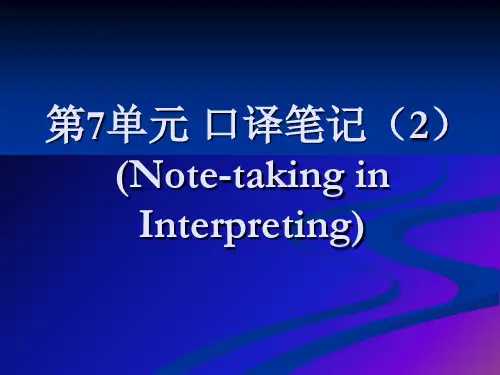
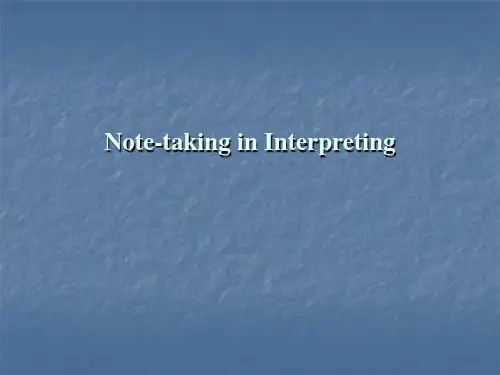
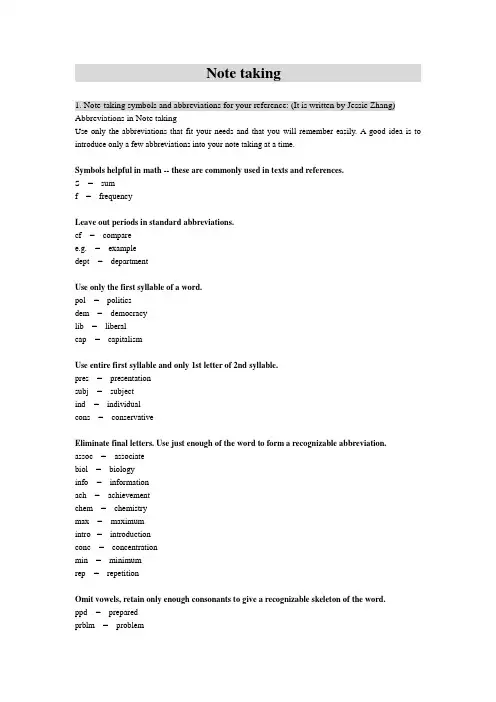
Note taking1. Note-taking symbols and abbreviations for your reference: (It is written by Jessie Zhang) Abbreviations in Note takingUse only the abbreviations that fit your needs and that you will remember easily. A good idea is to introduce only a few abbreviations into your note taking at a time.Symbols helpful in math -- these are commonly used in texts and references.S = sumf = frequencyLeave out periods in standard abbreviations.cf = comparee.g. = exampledept = departmentUse only the first syllable of a word.pol = politicsdem = democracylib = liberalcap = capitalismUse entire first syllable and only 1st letter of 2nd syllable.pres = presentationsubj = subjectind = individualcons = conservativeEliminate final letters. Use just enough of the word to form a recognizable abbreviation.assoc = associatebiol = biologyinfo = informationach = achievementchem = chemistrymax = maximumintro = introductionconc = concentrationmin = minimumrep = repetitionOmit vowels, retain only enough consonants to give a recognizable skeleton of the word.ppd = preparedprblm = problemestmt = estimatebkgd = backgroundgvt = governmentUse an apostrophe in place of letters.am’t= amountcont’d= continuedgov’t= governmenteducat’l= educationalForm the plural of a symbol or abbreviated word by adding s.chpts = chaptersegs = examplesfs = frequenciesintros = introductionsUse g to represent ing endings.ckg = checkingestg = establishingdecrg = decreasingexptg = experimentingSpell out short words such as in, at, to, but, for, and key.Abbreviations or symbols for short words will make the notes too dense with shorthand.Leave out unimportant words.Leave out the words a and the.If a term, phrase, or name is written out in full during the lecture, substitute initials whenever the term, phrase, or name is used again. For example, Center for Aerospace Sciences becomes CAS thereafter.Use symbols for commonly recurring connective or transitional words.& = andw/ = withw/o = withoutvs = against\ = therefore= = is or equalUse technical symbols where applicable.zb = German, for exampleibid = Latin, the same worko = degreesH2O = water1b/ exercise:Establish a set of symbols or abbreviations for the following words: CountryImportExportGovernmentPolicyEconomySocietyEnergyEnvironmentNegotiaionsDebatePowerCenturyMonthWeekConferenceControlDecisionDivisionSay, affirm, declare, state etc.Think, deem, conceive, etc. WantMust, have toNeedChangeAgree, approve of Disagree, reject Increase, rise, go up Deacrease, fall, go down MeasureDecideDivideTypeDependIndependence AgreementPlan, programMarketWorldLevelExampleCause, reasonEffect, consequence PopulationIndustryImportantTreatyStateDevelopmentTransportSectorPriceCommittee, commissionCompetitionExpenditure,IncomeResourceProductionOrganizationMore reference:Use standard maths, accounting, and science symbols. Examples:+ plus// parallelUse standard abbreviations and leave out full stops. Examples:eg exampleIT dept Information Technology departmentUK United KingdomUse only the first syllable of a word. Examples:mar marketingcus customercli clientUse the entire first syllable and the first letter of the second syllable. Examples: subj subjectbudg budgetind individualTo distinguish among various forms of the same word, use the first syllable of the word, an apostrophe, and the ending of the word. Examples:tech'gy technologygen'ion generalisationdel'y deliveryUse just enough of the beginning of a word to form a recognisable abbreviation. Examples: assoc associatedach achievementinfo informationOmit vowels from the middle of words, retaining only enough consonants to provide a recognisable skeleton of the word. Examples:bkgd backgroundmvmt movementprblm problemForm the plural of a symbol or abbreviated word by adding 's.' Examples:custs customersfs frequencies/s ratiosUse 'g' to represent 'ing' endings. Examples:decrg decreasingckg checkingestblg establishingSpell out, rather than abbreviate short words. Examples:inbutaskeyLeave out unimportant verbs. Examples:iswaswereLeave out unnecessary articles. Examples:aantheIf a term, phrase, or name is initially written out in full during the talk or meeting, initials can be substituted whenever the term, phrase, or name is used again. Example:January Advertising Campaign Budget JACBUse symbols for common connective or transition words. Examples:@ at2 to4 for& andw/ withw/o withoutvs againstCreate your own set of abbreviations and symbols. You may wish to develop separate sets of symbols and abbreviations for different courses or subjects.Other Symbols and Abbreviationsas a result of / consequences of <--->resulting in --->and / also +equal to / same as =following ffmost importantly *less than <greater than >especially esp2. The following text is written by JEFFERY G一、缩略词英语当中缩略词使用的频率很高,如IMP: important, ASAP: as soon as possible。

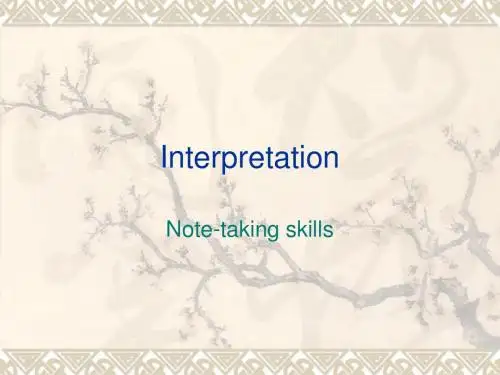
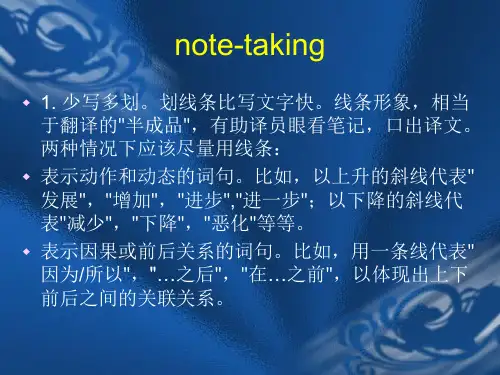

口译笔记法(Note taking in interpretation)Note taking in interpretation (1) 2007, Sunday, 04, 22, 17:00To directly talk about my notes by the use of experience.On some websites, I have seen suggestions from foreign interpretation teaching circles for many interpreters:1) See to it that the notes are logical and legible.2) To write as few words and symbols as possible.3) Better take notes in the target language.The first point of personal feeling is the most important, because interpretation notes should try hard to present the concept and structure of source language messages. (interpreter must convey a complete and logical message, including the tone, meaning, etc.) of the speaker Therefore, note taking in interpreting must have the characteristics of "Structurally-complete". Macro requirements as a wholeAs for the second point, I think it must be implemented on the premise of meeting the first point. It is not necessary to record information as little as possible, and ignore or even affect the basic requirements of interpreting notes -- structure. Micro detail requirementsAt third, I don't really agree. I think we should use the relatively good and relatively well identified language to record the source language and the target language. In addition,interpretation notes can be used in two languages. For example: the record of the concept of "I", "me" in Chinese and English "I", it is easy for us to choose the latter, because of its small strokes, fast and easy to distinguish; record, record "China", you can choose "" can also be written as "cn", because the two are to identify and record. Micro detail requirementsIn short, there are no special rules for the recording language of interpretation notes. As long as it conforms to the principles of "quick record and easy identification", my colleagues and I usually use two languages in interpreting.My interpretation note method (two) 2009-12-03 16:48 note is the key to advanced interpretation. The use of note is to supplement the short-term memory and endurance of the brain to ensure the accuracy of the translation and to ensure that it is not affected by the duration of the speaker.If it is completely dependent on memory and no unusual talent, even energetic young people are not qualified for advanced interpretation in terms of accuracy and endurance. As a practical example, I've met many times in my work. Senior interpreters don't have to rely on notes. However, the notes used in advanced interpretation are not consistent with the general concepts.Please note that each person's memory, thinking, and response have their own characteristics. There's no need to copy my way. The best way to take notes is to develop your own, suitable for their own system. My introduction is to give you a head, a direction, open the role of ideas.For example, the simpler the notes, the faster the record. But the notes are simple, and the requirements for short-term memory are relatively high. So, how much is the best note, easy because of people, need to find out for their own balance.The main point is:1. write fewer strokes. The line is faster than the writing. Line image, equivalent to the translation of "semi-finished product", helps the interpreter to see notes, speak out the translation. Two cases should use lines as much as possible:Words that express actions and movements. For example, the rising diagonal represents "development", "increase", "progress", "further", and "slash", "decrease", "deterioration" and so on with descending diagonals.Words and phrases indicating causality or pre and post relations. For example, a line represents "because / so"","... After "," in... "Before", in order to reflect the relationship between up and down.2. little words and more meanings. Develop a habit of taking notes of no more than one word. There are a large number of words in Chinese that are composed of two or more than two words. As long as you see one of them, your short term memory should be able to fill in the rest of the word. No need to write more. For example,"China" at most write a "medium"". "Beijing" writes "North" atmost". English words are also treated in the same way. "Politics" writes "poli", "government", "gov", and so on. In addition, it is necessary to develop the ability to interact with notes and memory; to see the ability of a word to speak a few words, or even a string of words. In context, it's not difficult. For example, talking about China's current situation, listening to "reform, opening up", remember a "change" word, it is not difficult to tell the original text from short-term memory. When you hear "British Prime Minister Tony Blair", remember "PM", also can say the original text.3. little lines and more fingers. Generic small line / mark. Otherwise, in their own familiar Chinese and English, and compiled a set of unfamiliar with the use of code, will lead to need to think about what symbol to use, counterproductive.4. less horizontal more vertical. Take the ladder structure from the top down and record the horizontal record as little as possible when you write it. The ladder structure vividly reflects the logical structure of the context, simplifies the thinking process of the interpreter, and facilitates the translation.5. fast writing. We must develop our own Chinese character fast writing system. Note taking is entirely self - observation, and it only takes a few minutes to read. Many strokes of Chinese characters are reduced without affecting recognition. I speak of here is not sloppy, but in addition to the actual interpretation often have to scribble, take some time to practice or work in interpreting word ponder, can look at how to reduce stroke or stroke, straighten out a word.6. clear end. In interpreting, the speaker says a paragraph, stops, makes an interpreter, and then goes on. In this way, there must be definite boundaries between the previous paragraph and the next paragraph. At the end of the last time, it became the beginning of the next translation. Its importance is that, if the notes are started from the 1/3 book, the next paragraph may write a 2-3 page, turn back when interpreting, eyes cannot determine which line the top of the page, or is the starting point of the symbol translation content. So you need to mark it. When I first started, I learned that every speaker made a line at the end. Later found, from the speaker opening, to that time I had to speak as an interpreter is very valuable, are often used to supplement notes, reluctant to draw the line to end. Later, I just put off the procedure until I finished the translation. As I finished speaking, and the speaker started this time within my grasp, so when I finished, I made a line, and then motioned the speaker to continue.Besides, I don't think the line is clear enough, so now turn it into a circle and a line.Finally, talk about the equipment you need.I suggest you use a notebook with a loose ring, see the following photos. It's easy to flip back and forth with a loose ring. The size of your laptop is comfortable. I like to use A5 made in england. I lay in my hand, just right. It's just British notebooks that are designed for shorthand. Blank pages are more ideal.Finish a page, turn over a page. The speaker after closing, grabbed all turn back, left eye is at the beginning of this piece of. Then, translate a page, turn over a page. After the translation, the pages of the past are pressed into the palm of the hand. This is a clear separation of the past and the next paragraph with the palm of the hand. That's important. Otherwise, it is prone to the speaker after the closing, the home page for your back and forth embarrassment.If you're sitting at your desk, your laptop is on the desk, and you're finishing a page, turning over a page. Don't forget to press the completed notes page to your notebook before the speaker speaks.Pen, I suggest using a press type. In this way, a handheld book, the other hand can always take out a pen, a press began to remember. If the pen is rotated, it needs two hands to operate. If the cap is not tight, but also from time to time off, a distraction. Generally I am used to bring two pens,Too many times to avoid the exhaustion of inkNote taking symbols 32009-08-25 22:25 two, letters and images Z represent "human" people/person, because "Z" looks like a head, and it is usually written in the upper right corner of a word or symbol. For example: Japanese: JZ. C stands for government, rule: government, govern, Greek letter C, /ga:ma/, approximate government, so C is used to represent govern, government. Governmental official can be expressed as CZ P representing Politics: politics, political, Greek alphabet P, /pai/, approximate politics, political. Then politician can beexpressed as PZ E representing the total number: total, totally, entire, entirely, on the whole, all in all, to sum up, ect. E mathematical notation representing the total value. G represents efficiency: efficient, effective. G is the symbol of efficiency. Q stands for inflation: inflation, because the sign resembles a rising balloon. A means agriculture: agriculture. agriculture is often used, so use initial letters instead. B represents business: business. C X represents conflict and contradiction: "X" in conflict, confrontation "C X" stands for opposition, and the letter "C" reduces the concept of opposition to conflict and confrontation. W means work, profession: work, employ, etc.. It's the first letter of work. So WZ can be used to represent worker, and W (Z is employer above the letter, employee below the letter). I stands for Industry: industry, industrial letter I is like a chimney, so it can be used to represent industry. U U looks like a goblet, and says in the note that the Treaty (agreement) is generally expressed only after successful negotiations and agreements". If it is filled with 2 x x in U, it can be expressed as bilateral (two-sided), and 3 is expressed as trilateral (three sides). Fill in U, fill in 1, say: Unilateralism (unilateralism), fill in M (multiple) to express multilateralism.Note the symbol 52009-08-25 22:29 said: ups and "twists and turns" downs, twists and turns, etc. four, said that "more" + mathematical symbols: many, lots of, a great deal of a good, many of, etc. + + (+2) said "comparative" more +3 said: "the most advanced multi" Most said: "little": little, few, lack, in short of/ be in shortage of etc. * said "error", "error" and "bad" concept: wrong/incorrect something, bad, notorious, negative, etc. > said "more than" bigger/larger/greater/morethan/better than etc., the concept of "high the concept of" superior to, surpass, etc., "said" less than "concept:less/smaller etc. said," low "concept: inferior to, etc. =" equal "concept: means that, is to say, in othe R words, the same as, be equal to etc., said the "rival" concept: a match, rival, competitor, counterpart, etc. () said "... Between...": among, within, etc. and said "different" concept: be different from etc., said the "invincible" concept: matchless, peerless etc. said, "about" concept: about/around, or so, approximately, etc. / said "no", "eliminate" concepts such as: cross out, eliminate, etc.Five, punctuation, etc.: a variety of verbs that say "say", "speak", "talk", "marks", "announce", "declare", "etc.", "", "question", and "issue", for example: "TW"(DOT) the position of this "." point is different. The concept of ".D" means "yesterday", ".Y" means "last year", ".2m" means two month ago. "Y" this year, "y2." two year later "next week", "wk." can be expressed as a representation of "good" when turning said state, right/good, famous/well-known etc., said "agree", stand up for, support agree, with sb, certain/ affirmative, etc. said, "" state: important, exemplary (model) best, outstanding, brilliant, etc. n, said the "communication" state: exchange, mutual, etc. & said "and", "and" and together with, along, with, accompany, along, with, further, more, etc., said "the end": end stop, halt, bring, sth to a standstill/stop etc., six, a long word processing method -ism - M for example: socialism Sm -tion - N Standardization: Jane (for example Standard) stdn -cian Jane - O for example: technician techo -ing - G for example: Marketing (Marketing) MKTg -ed - D acceptedacptd -able/ible/ble for example: for example: available avbl - BL - MT -ment amendment amdmt -ize for example: Jane wrote for the Z example: recognize regz -ful - FL for example: meaningful mnflA collection of shorthand symbols for interpretation! (1) 2007-01-04 19:09:04, medium and small. Abbreviations:Abbreviations in Note takingUse only the abbreviations that fit your needs and that time. you will remember easily. A good idea is to introduce only a few abbreviations into your note taking at a1.Symbols helpful in math -- these are commonly used in texts and references.S = sumF = frequencyLeave out periods in standard abbreviations.CF = compareE.g. = exampleDept = DepartmentUse only the first syllable of a word.Pol = politicsDEM = democracyLib = liberalCap = capitalismUse entire first syllable and only 1st letter of 2nd syllable.Pres = presentationSubj = subjectInd = individualCons = conservativeEliminate final letters. Use just enough of the word to form abbreviation. a recognizableAssoc = AssociateBIOL = biologyInfo = informationACh = achievementChem = chemistryMax = maximumIntro = introductionConc = concentrationMin = minimumRep = repetitionOmit vowels, retain only enough consonants to give a recognizable skeleton word. of thePPD = preparedPrblm = problemEstmt = estimateBkgd = backgroundGVT = governmentUse an apostrophe in place of letters.Am't = amountCont'd = continued政府=政府educat'l =教育形成一个符号或缩写词的复数加schpts =章EGS =实例FS =频率介绍:介绍用g表示ing结尾。
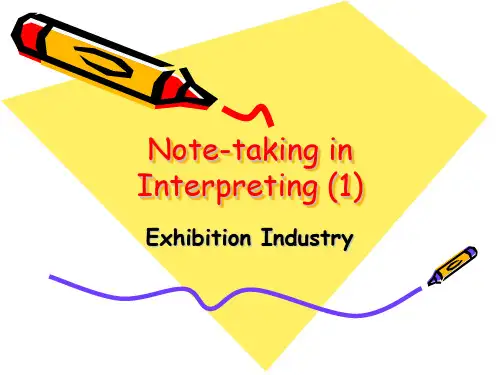
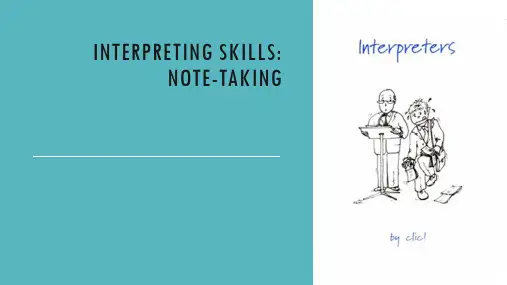
NOTE-TAKINGNOTE-TAKINGWhy shall we take notes?为什么要记笔记?What instrument does an interpreter need?口译工具What shall we take?记什么?How shall we take?怎样记?What makes note-taking different from other kinds of text recording?口译笔记特点?Why shall we take notes?为什么要记笔记?Watch video 4.1, 4.2WHY TAKE NOTES?记不全;记不住;记不准。
Very short consecutive:sentence by sentence;clause by clause for interpretingShort consecutive(30-40s):business interpreting,community interpretingMedium-length consecutive (45-90s):more developed note-taking techniqueLong or full consecutive(2mins)Very long consecutive(over5mins)1.an aid to supplement memory(有助于储存记忆)2.at delivery, as clues for recalling(提示)3. to help visualise the structure and logic of source WHY TAKE NOTES?language speech(有助于理清原文结构与逻辑)4.help to organise target language reproduction(有助于组织目标语)WHAT INSTRUMENT DOES AN INTERPRETER NEED?口译工具VIDEO 4.2 ( -4’45)INSTRUMENTA spiral notepad/steno pad(上翻式线圈本)15.24cm-22.86cm two retractable pen(按压式圆珠笔)What Shall we write on notepad? WATCH VIDEO 4.4 (1)WHAT SHALL WE WRITE ON NOTES?Listen/read to the following passage for interpreting,take notes when you feel necessaryA human baby produces its first real words at about eighteen months of age.By the age of two,it has become quite vocal and has a vocabulary of some fifty words. Over the next year it learns new words daily,and by the age of three it can use about1000words.It is now stringing words together in short sentences of two or three words,calling your attention to objects,requesting this and that.Its command of grammar is already nearly as competent as an adult’s,though it will make amusing yet plainly logical mistakes,saying‘eated’instead of‘ate’,‘mouses’instead of‘mice’, and so on.Then the floodgates open.By the age of six,the average child has learned to use and understand around13,000words;by eighteen,it will have a working vocabulary of around60,000words.WHAT SHALL WE WRITE ON NOTEPAD?cue words(information capture)➢keywords/elements➢Transcodable elements(numbers;names;technical terms,list, motivated expressions)➢Links and transition➢Grammatic elements✓LogicHOW TO TAKE NOTES?HOW TO TAKE NOTES?✓How to illustrate logic?(layout格式)✓How to write down the cue words?(Information capture) simplification, abbreviation and symbolswatching the video and observe what the interpreter wrote on pad and how she wrote the information.So traditionally, semester upon semester, for the past several years,this course, again, a hard course, had a failure rate of about 40 to41 percent every semester. With this blended class late last year, thefailure rate fell to nine percent. So the results can be extremely,extremely good. Now before we go too far into this, I‘d like to spendsome time discussing some key ideas. What are some key ideas thatmakes all of this work? One idea is active learning. The idea here is,rather than have students walk into class and watch lectures,wereplace this with what we call lessons. Lessons are interleavedsequences of videos and interactive exercises. So a student mightwatch a five-, seven-minute video and follow that with an interactiveexercise. Think of this as the ultimate Socratization (Socrates,socratic) of education. You teach by asking questions. And this is aform of learning called active learning, and really promoted by avery early paper, in 1972, by Craik and Lockhart, where they saidand discovered that learning and retention really relates strongly tothe depth of mental processing. Students learn much better when theyare interacting with the material.EXAMPLE✓How to illustrate logic?(layout) Watch video 4.2 (4’45-end)❖纵向VERTICALISATION:上下安排,多分行,每行一个意群,易于快速读取,不费眼神。
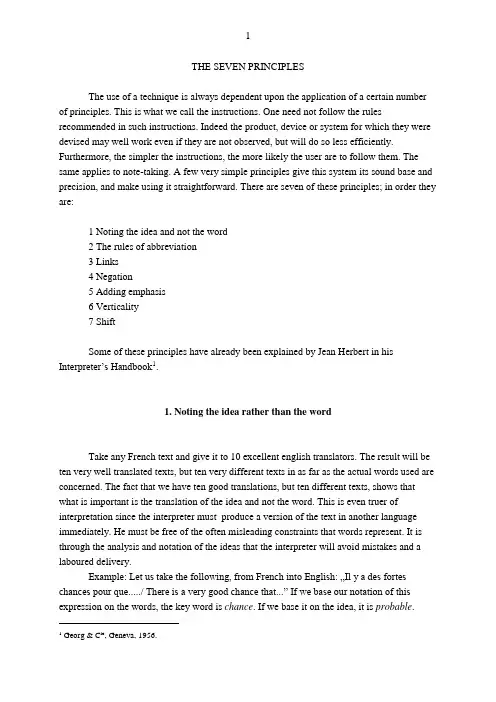
THE SEVEN PRINCIPLESThe use of a technique is always dependent upon the application of a certain number of principles. This is what we call the instructions. One need not follow the rules recommended in such instructions. Indeed the product, device or system for which they were devised may well work even if they are not observed, but will do so less efficiently. Furthermore, the simpler the instructions, the more likely the user are to follow them. The same applies to note-taking. A few very simple principles give this system its sound base and precision, and make using it straightforward. There are seven of these principles; in order they are:1 Noting the idea and not the word2 The rules of abbreviation3 Links4 Negation5 Adding emphasis6 Verticality7 ShiftSome of these principles have already been explained by Jean Herbert in his Interpreter’s Handbook1.1. Noting the idea rather than the wordTake any French text and give it to 10 excellent english translators. The result will be ten very well translated texts, but ten very different texts in as far as the actual words used are concerned. The fact that we have ten good translations, but ten different texts, shows that what is important is the translation of the idea and not the word. This is even truer of interpretation since the interpreter must produce a version of the text in another language immediately. He must be free of the often misleading constraints that words represent. It is through the analysis and notation of the ideas that the interpreter will avoid mistakes and a laboured delivery.Example: Let us take the following, from French into English: …Il y a des fortes chances pour que...../ There is a very good chance that...” If we base our notation of this expression on the words, the key word is chance. If we base it on the idea, it is probable.1 Georg & C ie, Geneva, 1956.The notes will have to be read 20 minutes – even an hour2– after the idea was originally expressed. In the first example it would be very easy to make a mistake. Having noted chance the interpreter might, if the context allowed, render it …there is a chance that” or …by chance”. If on the other hand he noted probable the mistake cannot be made. The issue of style is also dealt with in the second example where one would automatically say (interpreting into English), …It is probable that”, or …it is likely that”, or …in all likelihood” whereas in the first example even if the interpreter had correctly recalled the idea that the word chance represented he/she will be a prisoner to that word and might easily produce a gallicism3.Example: …We should try to live up to....”. It would be absurd to note the word …live” and it would greatly increase the risk of making a mistake. Although it would seem to be very different from the original it wou ld be more appropriate to note in French, for example, … à la hauteur” (in english ‘to be up to’). This is the result of analysing the idea behind what is said and noting it idiomatically in the target language. It would be just as useful to note be =, representing being equal to , which could very easily be read back idiomatically in intepretation (ie. …à la hauteur in French”, …to be up to in English”).Whenever taking notes the interpreter must concentrate on the major idea and how this can be noted clearly and simply (preferably in the target language, although this is not essential).In the practical exercises in Part 3 of this book you will find a number of examples of noting the idea rather than the word. It is recommended that you examine these with particular care.2. The Rules of AbbreviationA. ABBREVIATION OF WORDSThe rule of thumb is that unless a word is short (4-5 letters) the interpreter should note it in an abbreviated form.If we have to note …specialized” it is more meaningful and reliable to note sp ed than to write spec.2 this was indeed the case when Rozan wrote. Although nowadays 20 minutes is considered a long consecutive speech, his comments still apply.3 being unduly influenced by the source language is, of course, not only a problem in French-English interpretation but in all interpretation.B. INDICATING GENDER AND TENSEHaving abbreviated a word or an idea (be it by the use of a symbol or a contraction of its component letters) it can also be very helpful to give an indication of gender4 and tense).Thus in the expression: …I will come back to this a little later”, noting the future tense will render the words …a little later”superfluous. We will see below that …I speak” can be noted : I ”. Therefore we note : I ll”The expression: …those mentioned”, must be noted : rf d; because rf alone could be read back as …those which mention”.Rule: To indicate gender5 and number we add e or s to the symbol or abbreviation. To indicate tense we add ll for the future and d for the past.See also the examples in Part 3.C. ABBREVIATING THE REGISTERThe expression …which have contributed to” is long. The word help is short. Wherever possible we must abbreviate by using a word which conveys the same meaning but is shorter.Similarly, …...which are worth looking at” can be noted int g (interesting).…In order to arrive at some conclusions” can be noted to end.…Taking into account the situation at the present time” can be noted as sit on now.Examine closely the abbreviations in Part 3.3. LinksThe part of any speech that is both the most important and the most difficult to note is the sequence of ideas and the links between them. (Jean Herbert)An idea can be distorted completely if its relation to the previous idea is not clearly indicated. When taking notes then, we should never miss out the links. Indeed what we4 Rozan was working from and into French. Gender is meaningless for those noting in English, however, the idea could be usefully adapted for use in, for example, the Slavic languages where nouns have gender.5Again the ‘e’ represents the French feminine ending. Any letter can be used and this will depend on the languages involved.actually see is that if the links are noted well the rest of the idea can be summarised in just a few strokes of the pen.A. Noting links becomes very simple if we use the key words that follow. (Over time this will become automatic.)as, why and that is because, this is the reason why, since, given the fact that, (in some instances) given that; to convey explanation.tho although, despite the fact that; to convey oppositionbut on the other hand, but, nevertheless, however; to convey limitationsif it is possible that, assuming that; to convey supposition.as to as far as x is concerned, on the matter of; to convey referencetfe therefore, one can then conclude; to convey conclusion.The three symbols below (which can also be found in Part 2) are also extremely useful.=the same goes for, one might say the same of; to convey the idea ofequality or correspondanceon the other hand, contrary to; to convey the idea of difference or lackof correspondancein + in addition, furthermore, if we also take account of; to convey the ideaof additional precision.B. Linking is not just about representing the idea; it will often impacton the very content of the speech. It is a question of notingquickly and without repetition the group of subject words and thegroup of complement words to which the idea relates. This problemcan be solved quickly and easily by using the the recall arrow (JeanHerbert)Examine carefully the examples of links in Part 3.4. and5. Negation and emphasisNegation and emphasis are two essential elements of any speech and as such should be noted unambiguously (See Jean Herbert pp46-47).1. NEGATIONNegation might be noted by means of a line running through a word or symbol. Example:If we use OK to signify …agree”, then …disagree” will be OK . It is also possible to write the word no before the word to be negated (thus in our example we would note no OK). This second method is clearer and since …no” is a very short word using it is not a problem.2. EMPHASISTo emphasize a word we can underline it (twice if we are dealing with a superlative or absolute).Example:…(The study) is interesting” : int g…(The study) is very interesting” : int g…(The study) is extremely interesting” : int gIn some cases the line may be replaced by a circumflex to avoid confusion arising from the use of verticality.Alternatively emphasis can be noted with a dotted line.Example:…This report might be useful” : usefulThe use of underlining to denote nuance allows us to qualify the word (or idea) underlined without noting the qualifier.Example:…important question” becomes : ?…we should look at this very carefully” becomes : look at…I would like to say in the strongest possible terms” becomes : I say…...an imperfect solution” becomes : sol tn6. VERTICALITYIt is the principles of Verticality and Shift (described in the next section) which form the backbone of the note-taking system described in this book.Verticality means taking notes from top to bottom rather than from left to right. This method makes it possible to:a) group ideas logically, allowing a complete and immediate synthesis when we come to read back our notes,b) to do away with many links which would otherwise be essential to the clarity of the text.A. STACKING…Stacking6” consists of placing different elements of the text above or below one another.B. USING BRACKETSBrackets are an important part of the verticality system. In every speech there will be certain elements, which are mentioned to clarify an idea or to highlight a particular point, but which are not integral to the speaker’s train of thought.These parts of a speech should be noted in brackets, below the main element to which they refer.To encourage a natural use of the verticality technique it is recommended that you use relatively large but narrow pieces of paper. This will allow you to note the maximum amount of text on one page whilst automatically bringing your notes back to the left hand side of the page.7. SHIFTShift and Verticality are the fundamental principles underlying this note-taking system.To explain Shift let us take an example: …Over the course of 1954, prices rose, although not to the same extent as income, thus the population’s net income increased.” Our notes will be as follows ( the symbol denotes increase):Having used Shift to give our notes a vertical layout on the page, noting the links is almost enough to give us an accurate and full version of the text.6…Superposition” in FrenchShift means writing notes in the place on a lower line where they would have appeared had the text on the line above been repeated.。
高口听力Note-taking & Gap-filling 考前抢分刘寒露倒计时Day 8(1)一.答题技巧各位同学们大家好,马上又到了2012年春季口译考试的时间了,在3.18 日这一次的口译考试中,我们同样为大家准备了应考必读栏目,提醒考生需要注意的事项,包括对考试的流程的熟悉和对各种题型解题技巧的掌握。
今天刘寒露老师要为大家讲解的,是高级口译听力考试中的Note-taking & Gap-filling 题型(以下简称NTGF)。
首先我们来回顾一下该题型的考察流程,以及在每个步骤,考生应该如何操作。
NTGF是高口听力下半场的第一个题目。
考生回到座位上,首先是拿不到试卷和答题纸的,大家首先拿到的是一张空白的笔记纸,笔记纸大小在16K,比常用的A4纸小一些。
笔记纸有一面是完全空白的,另一面有3行左右的文字,写的是NTGF这个题目的direction。
考生拿到笔记纸,先翻到完全空白的那一面,准备做笔记,如果此后空白面不够用,再用另一面。
笔记纸发放完毕后,开始播放听力录音,中速的录音将持续6分钟之久,对考生的体力和脑力都是巨大的挑战。
这一阶段,要求考生一定要坚持到底,持续笔记,坚持到底就是胜利。
考场上的笔记持久力从哪里来呢?首先,来自于平时完整的练习,我们建议考生在迎考复习时,用完整的时间来练习听力部分的所有题目。
把历年真题当成完整的考试来练习,以提早适应考试对精神和体力的要求。
另外,考试现场如果实在记不动笔记了,建议考生看一下周围的考生,同为考生,大家总能相互鼓舞。
那么,笔记的要领又在哪里呢?首先,对于篇章,考生首先考虑记录的是框架,框架包含主话题,还有若干个分话题,这些在原文中一般是名词和名词词组,所以应该优先记录代表话题的名词和名词词组。
其次,第二级重要的内容是数字,我们在授课的时候多次提到,数字是对于所有题型都十分重要的一个考点。
当然,仅仅记录数字是不够的,考生需要把数字和数字的相关信息,也就是数字说明的内容一起记下来才行。
Note-taking 口译速记笔记本大小以自己感觉舒服为准。
笔,建议用按压式的。
Key points :1.少写多划。
划线条比写文字快。
表示动作和动态的词句。
比如,以上升的斜线代表"发展","增加","进步","进一步";以下降的斜线代表"减少","下降","恶化"等等。
表示因果或前后关系的词句。
比如,用一条线代表"因为/所以","…之后","在…之前",以体现出上下前后之间的关联关系。
2. 少字多意。
养成一个词的笔记不超过一个字的习惯。
3. 少横多竖。
4. 汉字快速书写。
5. Use as many symbols as you feel comfortable with + 还有,和,此外,而且,以及 - 减少, 不会,没有 = 等于, 相当于 > 大过,超过,优越于 < 少于,小于,比不上 ↓ 减少,下降 ↑ 增加,上升,上报 ↗ 逐步增加 ↘ 逐步下降,减少 → 向前发展e abbreviations “Prof” for “professor”, “dept” for “department”, “std” for “standard”. “ref” for “reference”, “eg” for “for example”, “ie” for “that is”, “esp” for “especially”, “min” for “minimum”, “max” for “maximum”, and “usu” for “usually” cf for compare std standard SH shanghai GDP (gross domestic product), GNP (gross national product), 5yr P (five year plan), SOE (state owned enterprise), FIE (foreign invested enterprise), JV (joint venture), SEZ (special economic zone), trd (trade), invt (investment), respon (responsibility), memo (memorandum), demo (demonstration), Ad (advertisement), TQC (total quality control 全面质量管理), CI (corporate image 企业形象), Attn (attention), dept (department), Exch (exchange), coop (cooperation), prodc (production), ref (reference), info (information), IT indy (information industry), telcom (telecommunication), IDD (international direct dialing), R&D (research and development), CAD( computer assisted design), agrd(agreed). CEO(chief executive officer), Govt(government), FOB (free on board), CIF(cost, insurance, fright)。
Note-takingThe Arrows1. the right arrow : export to, enter, arrive in, present to, give to, submit to, result in, send to, cause (出口,输出,打入,出国,到达,前往,派遣,交给,屈服于,运往,导致)2. the left arrow : come from, originate in, import from, receive from, come back to (来自,源于,进口,收到,回归到)3. the upward arrow : grow, expand, develop, rise, go up, strengthen, increase, improve, launch, ascend, skyrocket, promote (增长,扩大,提高,发展,升起,加强,上涨,发射,起飞,升空,提拔,晋升)4. the downward arrow : drop to, bomb, jump, decrease, descend, go down, deteriorate, demote, reduce (向下,轰炸,跳水,下跌,下降,减少,恶化,降职,削减、裁减)5. the right upward arrow : increase/rise/go up gradually6. the right downward arrow : decrease/go down graduallyMathematical Symbols+ 加上,另外,除此以外(plus, and, in addition to, furthermore)- 减去,缺乏,缺少minus, lackX 不对的,错的,坏的,不好的,臭名昭著(incorrect, wrong, bad, notorious)>大于,好于,超过,优于,越来越(greater, larger, more than, better than, surpass, superior to, more and more)<小于,少于,不如,次于,逊色(smaller/fewer/less than, worse than, inferior to)≧多于或等于more than or equal to≤ 少于或等于(less than or equal to)=等于,相当于,是…的对手(equal to, equal, the same as, a match/rival/competitor for sb.)≠ 不等于,不是…的对手(not equal to, no match for)≈ 大约,左右(approximately, around, or so)∵由于,因为(as, because, owing to, due to, thanks to)∴所以,因此,因而,结果(consequently, so, therefore)Punctuation Marks: 说,讲,告诉,认为,宣称,声明,抗议,譬如… ,象… (say, speak, tell, declare, protest, such as, like). 观点,意见,主意,论点,难点(viewpoint, opinion, idea, difficult point)It can also express different time concepts. E.g. .y ..y m. m.. .d ..d d..() 包括,在… 之中/内,封闭,闭关自守,禁闭(in, including, within, among, inside, seclusion)Other symbols√ 正确,对,好,肯定,有名,著名,同意,支持(correct, good, affirmative, certain, well known, famous, agree, support)°人(person or people)☆最佳的,杰出的,优秀的,重要的,榜样(best, outstanding, excellent, important, model)⊙会议,研讨会,开会,讨论,谈判(meeting, seminar, meet, conference, discussion, negotiation)∧领导,管理(lead, manage)∪协议,协定,条约,合同(agreement, accord, treaty, contract)□ 国家(country, state, nation)「may be used before certain verbs to express future actions」may be used after certain verbs to express ―过‖,―了‖so as to avoid possible confusion in tense.& 和,与… 一起,陪同(and, together with, accompany)∽交流,交换,替代,相互(exchange, replace, mutual, each other)∑ 总和,总数(total, the total sum, totally)∥停顿,停止,终止(stop, halt)><对立,冲突(confrontation, conflict)△代表(on behalf of)AbbreviationsUNICEF 联合国儿童基金会IMF 国际货币基金WTO 世界贸易组织EU 欧盟(欧洲同盟)APEC 亚太经合组织(亚洲太平洋经济合作组织)OPEC 石油输出国组织NA TO 北约(北大西洋公约组织)CPC 中国共产党NPC 全国人民代表大会CPPCC 中国人民政治协商会议CAAC 中国民航CCTV 中央电视台PLA 中国人民解放军HKSAR 香港特别行政区GDP 国民生产总值Ch. govt. 中国政府re. op. 改革开放4 Ms 四个现代化tot. imp 进口总额tot. exp 出口总额NASA 美国宇航局FBI 美国联邦调查局GM 美国通用汽车公司ITT 美国电话电报公司US/Am. 美国UK/Br. 英国Can. 加拿大AUS. 澳大利亚N.Z. 新西兰NY 纽约Las. 洛杉矶US$ 美元Br£英镑Can$ 加元Euro 欧元$A 澳元NZ$ 新西兰元HK$ 香港元RMB 人民币野生动物保护区--野区北京市人民政府--北府改革开放--该开资本主义--资’代表性--代x科学性--科x四个现代化--4M合理化--合h企业家--企j上海--SH投资回报率--ROIFive –Year Plan(五年计划)--5yP野生动物保护区--野区北京市人民政府--北府改革开放--该开资本主义--资’代表性--代x科学性--科x四个现代化--4M合理化--合h企业家--企j上海--SH投资回报率--ROIFive –Year Plan(五年计划)--5yP政治家--政j北京--BJ合资企业--JVResponsibility—respInformation industry (信息产业)– IT indy Foreign Direct Investment (外资企业)--- FIENote-taking Examples1. 首先,请允许我代表中华人民共和国国防部和我所有的中国通行,并以我个人的名义,对约翰逊将军以及美国国防部的朋友们,表示衷心的感谢。
THE SEVEN PRINCIPLESThe use of a technique is always dependent upon the application of a certain number of principles. This is what we call the instructions. One need not follow the rules recommended in such instructions. Indeed the product, device or system for which they were devised may well work even if they are not observed, but will do so less efficiently. Furthermore, the simpler the instructions, the more likely the user are to follow them. The same applies to note-taking. A few very simple principles give this system its sound base and precision, and make using it straightforward. There are seven of these principles; in order they are:1 Noting the idea and not the word2 The rules of abbreviation3 Links4 Negation5 Adding emphasis6 Verticality7 ShiftSome of these principles have already been explained by Jean Herbert in his Interpreter’s Handbook1.1. Noting the idea rather than the wordTake any French text and give it to 10 excellent english translators. The result will be ten very well translated texts, but ten very different texts in as far as the actual words used are concerned. The fact that we have ten good translations, but ten different texts, shows that what is important is the translation of the idea and not the word. This is even truer of interpretation since the interpreter must produce a version of the text in another language immediately. He must be free of the often misleading constraints that words represent. It is through the analysis and notation of the ideas that the interpreter will avoid mistakes and a laboured delivery.Example: Let us take the following, from French into English: …Il y a des fortes chances pour que...../ There is a very good chance that...” If we base our notation of this expression on the words, the key word is chance. If we base it on the idea, it is probable.1 Georg & C ie, Geneva, 1956.The notes will have to be read 20 minutes – even an hour2– after the idea was originally expressed. In the first example it would be very easy to make a mistake. Having noted chance the interpreter might, if the context allowed, render it …there is a chance that” or …by chance”. If on the other hand he noted probable the mistake cannot be made. The issue of style is also dealt with in the second example where one would automatically say (interpreting into English), …It is probable that”, or …it is likely that”, or …in all likelihood” whereas in the first example even if the interpreter had correctly recalled the idea that the word chance represented he/she will be a prisoner to that word and might easily produce a gallicism3.Example: …We should try to live up to....”. It would be absurd to note the word …live” and it would greatly increase the risk of making a mistake. Although it would seem to be very different from the original it wou ld be more appropriate to note in French, for example, … à la hauteur” (in english ‘to be up to’). This is the result of analysing the idea behind what is said and noting it idiomatically in the target language. It would be just as useful to note be =, representing being equal to , which could very easily be read back idiomatically in intepretation (ie. …à la hauteur in French”, …to be up to in English”).Whenever taking notes the interpreter must concentrate on the major idea and how this can be noted clearly and simply (preferably in the target language, although this is not essential).In the practical exercises in Part 3 of this book you will find a number of examples of noting the idea rather than the word. It is recommended that you examine these with particular care.2. The Rules of AbbreviationA. ABBREVIATION OF WORDSThe rule of thumb is that unless a word is short (4-5 letters) the interpreter should note it in an abbreviated form.If we have to note …specialized” it is more meaningful and reliable to note sp ed than to write spec.2 this was indeed the case when Rozan wrote. Although nowadays 20 minutes is considered a long consecutive speech, his comments still apply.3 being unduly influenced by the source language is, of course, not only a problem in French-English interpretation but in all interpretation.B. INDICATING GENDER AND TENSEHaving abbreviated a word or an idea (be it by the use of a symbol or a contraction of its component letters) it can also be very helpful to give an indication of gender4 and tense).Thus in the expression: …I will come back to this a little later”, noting the future tense will render the words …a little later”superfluous. We will see below that …I speak” can be noted : I ”. Therefore we note : I ll”The expression: …those mentioned”, must be noted : rf d; because rf alone could be read back as …those which mention”.Rule: To indicate gender5 and number we add e or s to the symbol or abbreviation. To indicate tense we add ll for the future and d for the past.See also the examples in Part 3.C. ABBREVIATING THE REGISTERThe expression …which have contributed to” is long. The word help is short. Wherever possible we must abbreviate by using a word which conveys the same meaning but is shorter.Similarly, …...which are worth looking at” can be noted int g (interesting).…In order to arrive at some conclusions” can be noted to end.…Taking into account the situation at the present time” can be noted as sit on now.Examine closely the abbreviations in Part 3.3. LinksThe part of any speech that is both the most important and the most difficult to note is the sequence of ideas and the links between them. (Jean Herbert)An idea can be distorted completely if its relation to the previous idea is not clearly indicated. When taking notes then, we should never miss out the links. Indeed what we4 Rozan was working from and into French. Gender is meaningless for those noting in English, however, the idea could be usefully adapted for use in, for example, the Slavic languages where nouns have gender.5Again the ‘e’ represents the French feminine ending. Any letter can be used and this will depend on the languages involved.actually see is that if the links are noted well the rest of the idea can be summarised in just a few strokes of the pen.A. Noting links becomes very simple if we use the key words that follow. (Over time this will become automatic.)as, why and that is because, this is the reason why, since, given the fact that, (in some instances) given that; to convey explanation.tho although, despite the fact that; to convey oppositionbut on the other hand, but, nevertheless, however; to convey limitationsif it is possible that, assuming that; to convey supposition.as to as far as x is concerned, on the matter of; to convey referencetfe therefore, one can then conclude; to convey conclusion.The three symbols below (which can also be found in Part 2) are also extremely useful.=the same goes for, one might say the same of; to convey the idea ofequality or correspondanceon the other hand, contrary to; to convey the idea of difference or lackof correspondancein + in addition, furthermore, if we also take account of; to convey the ideaof additional precision.B. Linking is not just about representing the idea; it will often impacton the very content of the speech. It is a question of notingquickly and without repetition the group of subject words and thegroup of complement words to which the idea relates. This problemcan be solved quickly and easily by using the the recall arrow (JeanHerbert)Examine carefully the examples of links in Part 3.4. and5. Negation and emphasisNegation and emphasis are two essential elements of any speech and as such should be noted unambiguously (See Jean Herbert pp46-47).1. NEGATIONNegation might be noted by means of a line running through a word or symbol. Example:If we use OK to signify …agree”, then …disagree” will be OK . It is also possible to write the word no before the word to be negated (thus in our example we would note no OK). This second method is clearer and since …no” is a very short word using it is not a problem.2. EMPHASISTo emphasize a word we can underline it (twice if we are dealing with a superlative or absolute).Example:…(The study) is interesting” : int g…(The study) is very interesting” : int g…(The study) is extremely interesting” : int gIn some cases the line may be replaced by a circumflex to avoid confusion arising from the use of verticality.Alternatively emphasis can be noted with a dotted line.Example:…This report might be useful” : usefulThe use of underlining to denote nuance allows us to qualify the word (or idea) underlined without noting the qualifier.Example:…important question” becomes : ?…we should look at this very carefully” becomes : look at…I would like to say in the strongest possible terms” becomes : I say…...an imperfect solution” becomes : sol tn6. VERTICALITYIt is the principles of Verticality and Shift (described in the next section) which form the backbone of the note-taking system described in this book.Verticality means taking notes from top to bottom rather than from left to right. This method makes it possible to:a) group ideas logically, allowing a complete and immediate synthesis when we come to read back our notes,b) to do away with many links which would otherwise be essential to the clarity of the text.A. STACKING…Stacking6” consists of placing different elements of the text above or below one another.B. USING BRACKETSBrackets are an important part of the verticality system. In every speech there will be certain elements, which are mentioned to clarify an idea or to highlight a particular point, but which are not integral to the speaker’s train of thought.These parts of a speech should be noted in brackets, below the main element to which they refer.To encourage a natural use of the verticality technique it is recommended that you use relatively large but narrow pieces of paper. This will allow you to note the maximum amount of text on one page whilst automatically bringing your notes back to the left hand side of the page.7. SHIFTShift and Verticality are the fundamental principles underlying this note-taking system.To explain Shift let us take an example: …Over the course of 1954, prices rose, although not to the same extent as income, thus the population’s net income increased.” Our notes will be as follows ( the symbol denotes increase):Having used Shift to give our notes a vertical layout on the page, noting the links is almost enough to give us an accurate and full version of the text.6…Superposition” in FrenchShift means writing notes in the place on a lower line where they would have appeared had the text on the line above been repeated.。